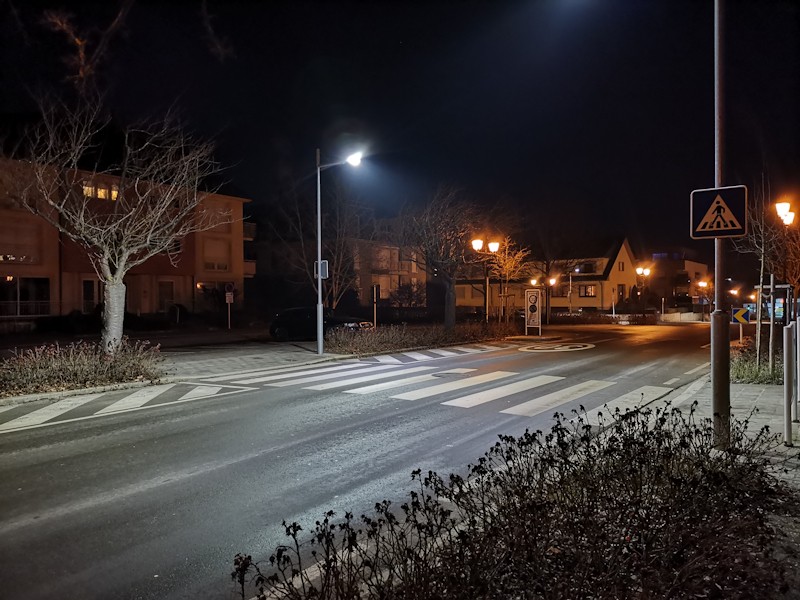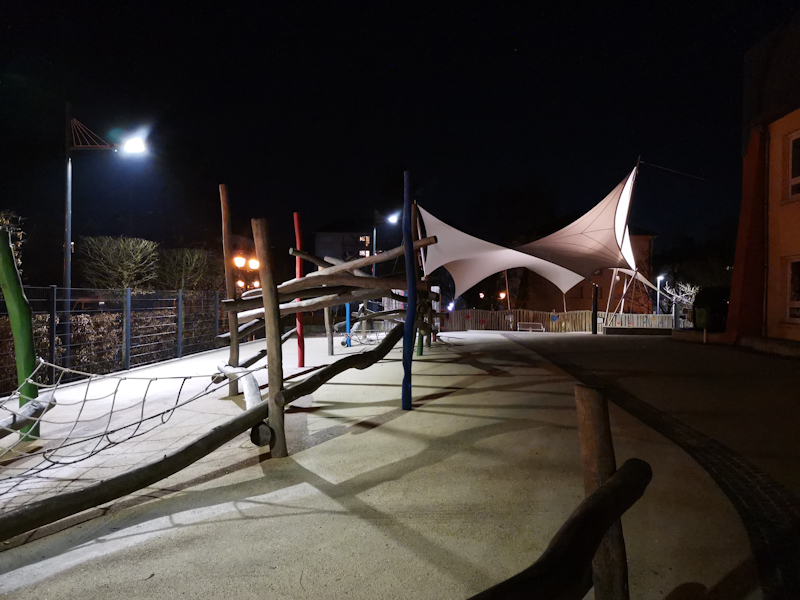Honor Launches The View20: A 48MP Camera Review
by Andrei Frumusanu on January 28, 2019 8:00 AM EST- Posted in
- Smartphones
- Mobile
- Kirin 980
- Honor View20
Camera - Low Light Evaluation
Low-light testing on the View20 is interesting. Here on one hand we should see the advantages of the big sensor in its pixel-binning mode, but on the other hand this might be a regression compared to the bigger 1µm 40MP sensors of the Huawei counterparts. Much like the P20 Pro and Mate 20 Pro, the View20 lacks an OIS mechanism that not only represents a disadvantage in terms of video recording, but also low-light capture. Let’s see how the new Honor device ends up in terms of low-light capture.

[ Honor View20 ] - [ Mate 20 Pro ]
[ Mate 20 ] - [ Galaxy Note9 ] - [ Galaxy S9+ ] - [ LG V40 ]
[ OnePlus 6T ] - [ Pixel 3 ]
The first shot unfortunately does confirms some of my fears about the new sensor: Although at first glance the result is very similar to the Mate 20 Pro, under closer inspection the View20 does have overall worse details and less sharp edges than what the flagship counterpart can achieve. Unfortunately this is a simple matter of light capture ability on the part of the sensor, and here the View20 only achieves 64% of the per-pixel area compared to the Mate 20 Pro.
The View20’s strength remains its processing ability, which still allows it to achieve quite good results compared to the competition.
The 48MP clear mode in effect is again no better than the 12MP mode, both in detail and exposure. We’ll see this behaviour to be true of all the low-light shots, and in effect I would have wished Honor’s software would have just reverted to a 12MP shot instead of needlessly generating a 48MP file.

[ Honor View20 ] - [ Mate 20 Pro ]
[ Mate 20 ] - [ Galaxy Note9 ] - [ Galaxy S9+ ] - [ LG V40 ]
[ OnePlus 6T ] - [ Pixel 3 ]
The next shot the View20 also ends up strikingly similar to the Mate 20 Pro. The phone’s advantages over the classical competition here isn’t solely due to the sensor, but as demonstrated by the regular Mate 20, can be largely attributed by the image processing and ISP of the new Kirin SoC.

[ Honor View20 ] - [ Mate 20 Pro ]
[ Mate 20 ] - [ Galaxy Note9 ] - [ Galaxy S9+ ] - [ LG V40 ]
[ OnePlus 6T ] - [ Pixel 3 ]
In extreme low-light, the View20 seemed to have issues focusing correctly as all my 12MP shots ended up being blurry. The 48MP clear mode shots here better demonstrated the raw capture ability of the sensor, and it ends up with quite a good representation of the scene.
Switching over to the night mode, we get a significantly better result of the moonlit scene. In terms of pure light capture ability, the phone still lags behind Google’s Night Sight mode on the Pixel 3, even although this latter result is fantastically over-the-top in terms of how bright it managed to make this dark scene.
Overall, good low-light capture
Overall the View20’s low light capture ability is very similar to the Mate 20 Pro and more recent Huawei devices. This means that they’re quite top performers exceeding the ability of classical smartphone cameras which don’t employ new computational photography modes.










37 Comments
View All Comments
philehidiot - Wednesday, January 30, 2019 - link
You'd be amazed when you go back to old phones with older sensors. I found a dick pic from about 4 or 5 years ago and you'd be amazed at how grainy and small it looked with the optical distortion. Only goes to show how much effort they've put into the lenses and how things incrementally improve over time.That's if you see grey hair as an improvement, that is.
phoenix_rizzen - Saturday, February 2, 2019 - link
Would be nice to have more than 3x optical zoom, too.Will be interesting to see results from the OPPO? phone with motors and extra horizontal lenses too see how their 10x zoom results look.
phoenix_rizzen - Saturday, February 2, 2019 - link
motors == mirrorsStormyParis - Monday, January 28, 2019 - link
Very interesting and insightful, thank you.I'm wondering how all those fancy AI-, Night-, ... modes deal with moving objects since they all seem based on some kind of HDR.
Andrei Frumusanu - Monday, January 28, 2019 - link
They take up to 4 seconds to capture so they're no good with moving objects.eastcoast_pete - Monday, January 28, 2019 - link
@Andrei: Thanks for this review. Did I get it correct - the 40 MP are more virtual than actual? I am curious how the Sony "40 MP" sensor compares to the very large 40 MP sensor in the Nokia Pureview 808. That sensor was a beast, and didn't just have 40 actual Megapixels, but also on-chip 4-in-1 binning. Any comments? Whatever happened to that sensor?Lastly, for any manufacturer who might read this: As somebody who really looks for a good camera in my phones, I for one don't mind a notable hump for the camera if (IF) you make it worth it in the photo and video quality.
eastcoast_pete - Monday, January 28, 2019 - link
Okay, I think I answered my own question: yes, the Sony chip is a "virtual" 40 MP, but that comes at a cost, mainly in form of really small imaging pixel size. I also took another look at the 41 megapixel Pureview sensor that Nokia's 808 featured: pixel size: 1.4 µm; 7728x5368 actual (not virtual) pixels, and a sensor size of 10.67 × 8.00 mm. When it came out, it monstered pretty much any compact fixed lens camera with better details and overall picture quality. I would love to see something similar in a smartphone with modern tech (Snapdragon 855 or Kirin 980), Android 9+, and BSI instead of FSI. For that, I take the big hump any day. Anybody else who'd be interested in that kind of kit?serendip - Monday, January 28, 2019 - link
I still have an 808 that gets used on sunny days. That said, my cheap Xiaomi phones have much better overall photo quality with Google Camera's HDR. The 808 has lovely detail rendering, almost like a Micro 4/3 sensor, but dynamic range is lacking and noise is terrible.Now someone needs to take that big sensor and marry it with a fast GPU and IP. Microsoft tried this with the Lumia 1020 but the SoC in that was too slow. A new Snapdragon 855 should be perfect for this.
tuxRoller - Friday, February 1, 2019 - link
Here's a comparison with the lumiawww.androidauthority.com/huawei-mate-20-pro-vs-nokia-1020-924642/
jjj - Monday, January 28, 2019 - link
Would be nice if you could also camera review the Xiaomi Redmi Note 7, just to see the differences between this and a 150$ phone.